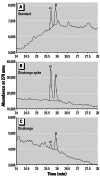Identification of metabolites of trenbolone acetate in androgenic runoff from a beef feedlot
- PMID: 16818248
- PMCID: PMC1874171
- DOI: 10.1289/ehp.8055
Identification of metabolites of trenbolone acetate in androgenic runoff from a beef feedlot
Abstract
Little is known concerning the potential ecological effects of hormonally active substances associated with discharges from animal feeding operations. Trenbolone acetate is a synthetic anabolic steroid that is widely used in the United States to promote growth of beef cattle. Metabolites of trenbolone acetate include the stereoisomers 17alpha- and 17beta-trenbolone, both of which are stable in animal wastes and are relatively potent androgens in fish and mammals. Our purpose in this study was to evaluate the occurrence of 17alpha- and 17beta-trenbolone in a beef cattle feedlot discharge and in river water upstream and downstream from the discharge. In conjunction with that effort, we measured in vitro androgenic activity of the discharge using CV-1 cells that had been transiently cotransfected with human androgen receptor and reporter gene constructs. Samples were collected on nine different occasions during 2002 and 2003. Whole-water samples from the discharge caused a significant androgenic response in the CV-1 cells and contained detectable concentrations of 17alpha- and 17beta-trenbolone. Further work is needed to ascertain the degree to which synthetic androgens such as trenbolone contribute to androgenic activity of feedlot discharges.
Figures




Similar articles
-
A critical review of the environmental occurrence and potential effects in aquatic vertebrates of the potent androgen receptor agonist 17β-trenbolone.Environ Toxicol Chem. 2018 Aug;37(8):2064-2078. doi: 10.1002/etc.4163. Epub 2018 Jul 5. Environ Toxicol Chem. 2018. PMID: 29701261 Free PMC article. Review.
-
Effect of growth promotants on the occurrence of endogenous and synthetic steroid hormones on feedlot soils and in runoff from beef cattle feeding operations.Environ Sci Technol. 2012 Feb 7;46(3):1352-60. doi: 10.1021/es202680q. Epub 2012 Jan 23. Environ Sci Technol. 2012. PMID: 22242694
-
Occurrence of trenbolone acetate metabolites in simulated confined animal feeding operation (CAFO) runoff.Environ Sci Technol. 2012 Apr 3;46(7):3803-10. doi: 10.1021/es204529v. Epub 2012 Mar 22. Environ Sci Technol. 2012. PMID: 22404689
-
Rates and product identification for trenbolone acetate metabolite biotransformation under aerobic conditions.Environ Toxicol Chem. 2015 Jul;34(7):1472-84. doi: 10.1002/etc.2962. Epub 2015 May 14. Environ Toxicol Chem. 2015. PMID: 25727029
-
MEAT SCIENCE AND MUSCLE BIOLOGY SYMPOSIUM--role of satellite cells in anabolic steroid-induced muscle growth in feedlot steers.J Anim Sci. 2014 Jan;92(1):30-8. doi: 10.2527/jas.2013-7077. Epub 2013 Oct 28. J Anim Sci. 2014. PMID: 24166993 Review.
Cited by
-
Risk assessment of growth hormones and antimicrobial residues in meat.Toxicol Res. 2010 Dec;26(4):301-13. doi: 10.5487/TR.2010.26.4.301. Toxicol Res. 2010. PMID: 24278538 Free PMC article.
-
Cumulative effects of in utero administration of mixtures of reproductive toxicants that disrupt common target tissues via diverse mechanisms of toxicity.Int J Androl. 2010 Apr;33(2):443-62. doi: 10.1111/j.1365-2605.2009.01049.x. Int J Androl. 2010. PMID: 20487044 Free PMC article. Review.
-
Cumulative effects of antiandrogenic chemical mixtures and their relevance to human health risk assessment.Int J Hyg Environ Health. 2017 Mar;220(2 Pt A):179-188. doi: 10.1016/j.ijheh.2016.11.007. Epub 2016 Nov 19. Int J Hyg Environ Health. 2017. PMID: 27923611 Free PMC article. Review.
-
A critical review of the environmental occurrence and potential effects in aquatic vertebrates of the potent androgen receptor agonist 17β-trenbolone.Environ Toxicol Chem. 2018 Aug;37(8):2064-2078. doi: 10.1002/etc.4163. Epub 2018 Jul 5. Environ Toxicol Chem. 2018. PMID: 29701261 Free PMC article. Review.
-
A Multidimensional Matrix Model for Predicting the Effects of Male-Biased Sex Ratios on Fish Populations.Environ Toxicol Chem. 2022 Apr;41(4):1066-1077. doi: 10.1002/etc.5287. Epub 2022 Feb 16. Environ Toxicol Chem. 2022. PMID: 35020961 Free PMC article.
References
-
- Ankley GT, Jensen KM, Makynen EA, Kahl MD, Korte JJ, Hornung MW, et al. Effects of the androgenic growth promoter 17β-trenbolone on fecundity and reproductive endocrinology of the fathead minnow (Pimephales promelas) Environ Toxicol Chem. 2003;22:1350–1360. - PubMed
-
- Bauer ERS, Daxenberger A, Petri T, Sauerwein H, Meyer HHD. Characterisation of the affinity of different anabolics and synthetic hormones to the human androgen receptor, human sex hormone binding globulin, and bovine gestagen receptor. Acta Pathol Microbiol Immunol Scand. 2000;108:838–846. - PubMed
-
- Durhan EJ, Lambright C, Wilson V, Butterworth BC, Kuehl DW, Orlando EF, et al. Evaluation of androstenedione as an androgenic component of river water downstream of a pulp and paper mill effluent. Environ Toxicol Chem. 2002;21:1973–1976. - PubMed
-
- Hewitt LM, Pryce AC, Parrott JL, Marlatt V, Wood C, Oakes K, et al. Accumulation of ligands for aryl hydrocarbon and sex steroid receptors in fish exposed to treated effluent from a bleached sulfite/groundwood pulp and paper mill. Environ Toxicol Chem. 2003;22:2890–2897. - PubMed
-
- Jenkins R, Angus RA, McNatt H, Howell WM, Kemppainen JA, Kirk M, et al. Identification of androstenedione in a river containing paper mill effluent. Environ Toxicol Chem. 2001;20:1325–1331. - PubMed
Publication types
MeSH terms
Substances
LinkOut - more resources
Full Text Sources

